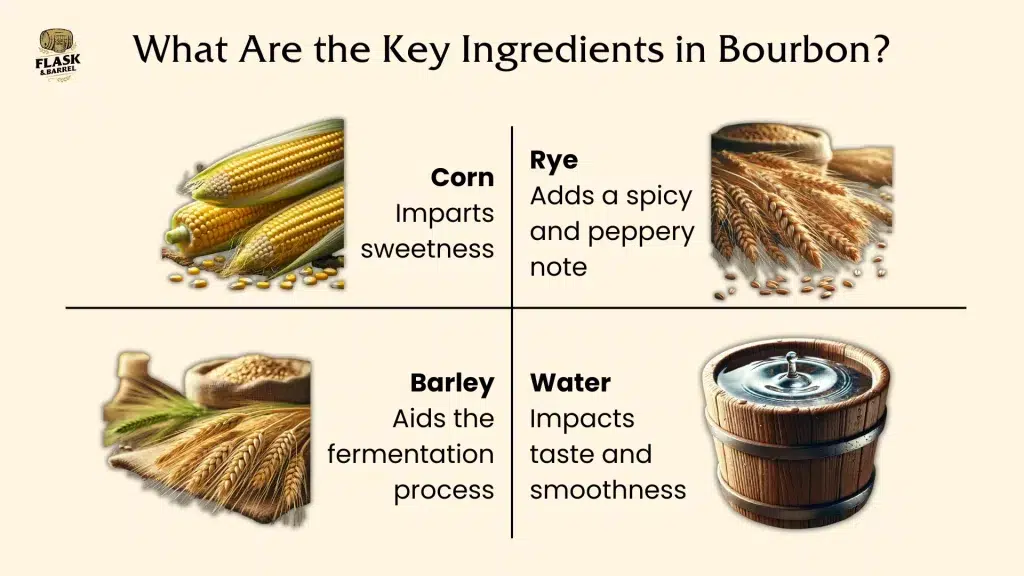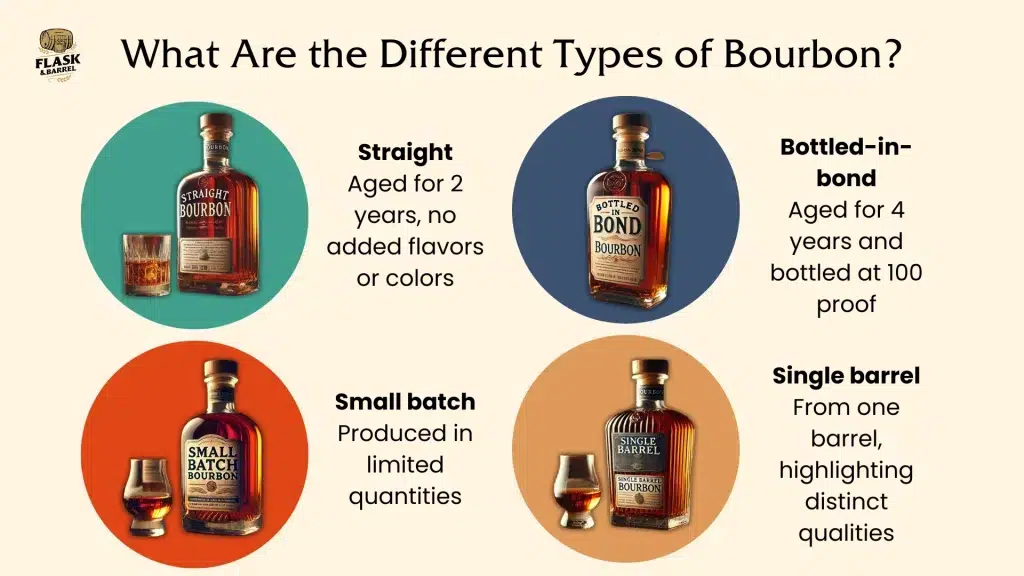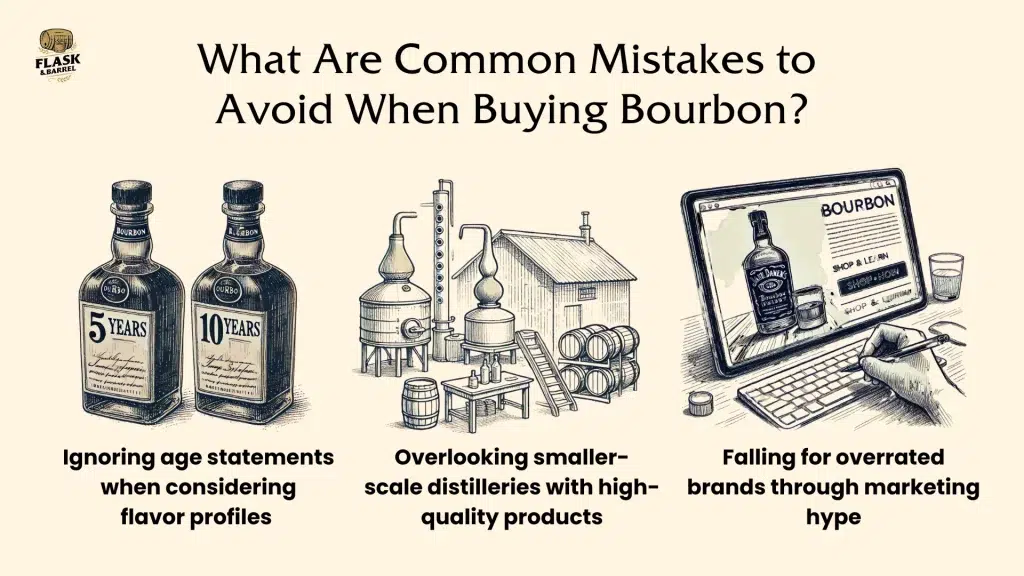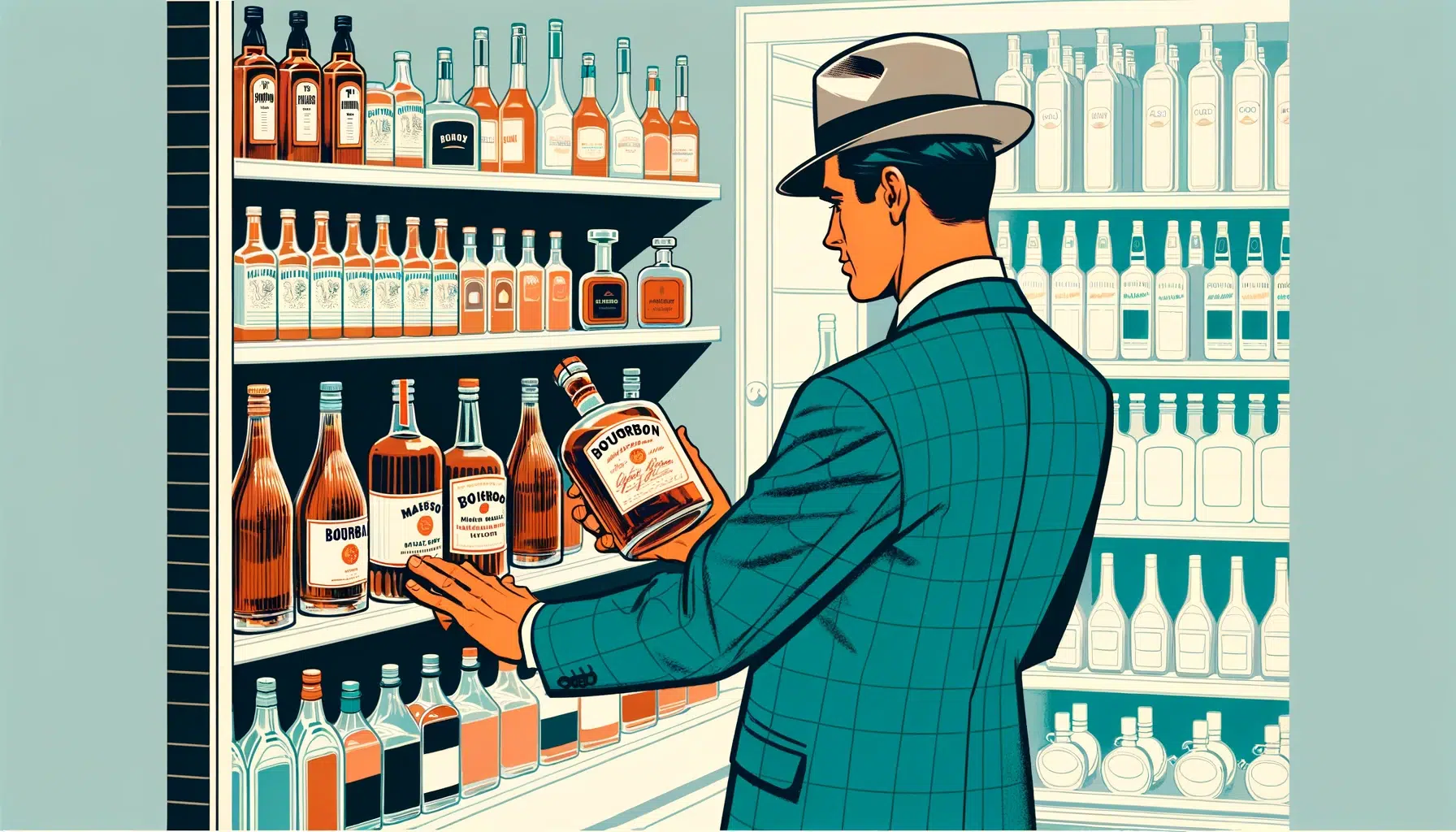Bourbon is often overshadowed by its Scotch and Irish counterparts, but it holds its own with a rich history and distinct flavor profile. This American classic is celebrated for its complexity and depth, offering a unique tasting experience that sets it apart in the world of whiskies. Key varieties of bourbon include Straight Bourbon, Small Batch Bourbon, and Single Barrel Bourbon, each bringing its own unique characteristics to the table.
Bottled-in-Bond Bourbon also deserves mention, providing a higher proof and a more intense flavor for those who seek it. Delving deeper, each type of bourbon showcases its own set of flavors, production methods, and historical significance. The following sections will explore these aspects in detail, providing a comprehensive guide to what makes bourbon a beloved spirit.
What is bourbon?
Bourbon is a type of American whiskey primarily made from corn. By law, the mash bill must contain at least 51% corn. The remaining ingredients typically include rye, barley, and sometimes wheat.
Bourbon must be aged in new, charred oak barrels, which impart its distinctive flavors and rich amber color. To be labeled as bourbon, it must be produced in the United States and meet specific legal requirements regarding its production and aging process. The result is a spirit known for its smooth, sweet, and often complex flavor profile, making it a favorite among whiskey enthusiasts.
What are the key ingredients in bourbon?
The primary ingredient in bourbon is corn, which must make up at least 51% of the mash bill. This gives bourbon its characteristic sweetness. Rye is often added to provide a spicy note, while barley contributes enzymes that aid in fermentation and add a subtle maltiness.
The water source is also crucial, as it affects the overall flavor and quality of the bourbon. Each ingredient plays a vital role in creating the rich, complex flavors that bourbon enthusiasts cherish.

Corn
Corn is the primary grain in bourbon, making up at least 51% of the mash bill. It imparts a distinctive sweetness to the whiskey, which is a hallmark of bourbon’s flavor profile.
Rye
Rye adds a spicy and peppery note to bourbon. Its presence in the mash bill can vary, but it significantly influences the overall taste, adding complexity and depth.
Barley
Barley contributes essential enzymes that aid in the fermentation process. It also adds a subtle maltiness to the bourbon, enhancing its flavor and texture.
Water source
The water source is crucial in bourbon production. The quality and mineral content of the water can significantly affect the final product’s taste and smoothness. Kentucky, known for its limestone-filtered water, is a prime example of how water quality can enhance bourbon.
How does aging affect bourbon?
Aging plays a crucial role in shaping bourbon’s flavor and character. The type of barrel used, typically new, charred oak, imparts rich flavors like vanilla, caramel, and oak. The duration of aging influences the depth and complexity of these flavors; longer aging often results in a smoother, more nuanced bourbon.
Climate also impacts aging; variations in temperature and humidity can accelerate the interaction between the bourbon and the barrel, enhancing its flavor profile. Each of these factors contributes to the unique taste and quality of the final product.
Barrel types
Barrel types significantly affect bourbon’s flavor. Bourbon must be aged in new, charred oak barrels, which impart rich flavors like vanilla, caramel, and oak. The charring process caramelizes the wood’s natural sugars, enhancing the bourbon’s complexity and depth.
Aging duration
Aging duration influences the depth and complexity of bourbon. Longer aging allows for more interaction between the whiskey and the barrel, often resulting in a smoother, more nuanced spirit. However, excessive aging can sometimes lead to overly woody flavors, so finding the right balance is key.
Climate impact
Climate impact plays a vital role in bourbon aging. Variations in temperature and humidity cause the bourbon to expand and contract within the barrel, accelerating the extraction of flavors from the wood. Regions with significant seasonal changes, like Kentucky, can produce bourbon with a richer and more complex flavor profile.
What are the different types of bourbon?
Bourbon comes in several varieties, each offering unique characteristics. Straight bourbon is aged for at least two years and contains no added flavors or colors. Small batch bourbon is produced in limited quantities from a select number of barrels, ensuring a more consistent and refined flavor.
Single barrel bourbon comes from one specific barrel, highlighting the distinct qualities of that particular batch. Bottled-in-bond bourbon adheres to strict regulations, including being aged for at least four years and bottled at 100 proof, guaranteeing a high-quality and robust flavor. Each type provides a different experience, catering to various preferences and tastes.

Straight bourbon
Straight bourbon is aged for at least two years and contains no added flavors or colors. This type adheres to strict guidelines, ensuring a pure and authentic whiskey experience. It offers a balanced flavor profile that showcases the natural characteristics of the grains and the aging process.
Small batch bourbon
Small batch bourbon is produced in limited quantities from a select number of barrels. This method allows distillers to create a more consistent and refined flavor profile. Small batch bourbons often offer a richer and more complex taste, making them a popular choice among enthusiasts seeking quality and uniqueness.
Single barrel bourbon
Single barrel bourbon comes from one specific barrel, highlighting the distinct qualities of that particular batch. Each bottle of single barrel bourbon can vary slightly in flavor, offering a unique tasting experience. This type of bourbon is prized for its individuality and the opportunity to taste the nuances of a single barrel’s aging process.
Bottled-in-bond bourbon
Bottled-in-bond bourbon adheres to strict regulations set by the Bottled-in-Bond Act of 1897. It must be aged for at least four years and bottled at 100 proof. This ensures a high-quality and robust flavor, as well as a guarantee of authenticity and consistency.
Bottled-in-bond bourbons are known for their bold and intense taste, appealing to those who appreciate a strong and well-crafted whiskey.
How does proof impact the flavor of bourbon?
Proof significantly impacts the flavor of bourbon. Higher proof bourbons, typically above 100 proof, tend to have more intense and concentrated flavors. These bourbons often exhibit stronger notes of spice, caramel, and oak, providing a robust tasting experience.
Conversely, lower proof bourbons, generally below 90 proof, offer a milder and smoother flavor profile. These bourbons are often more approachable, with subtle notes of vanilla, fruit, and sweetness. The proof level can also affect the bourbon’s mouthfeel, with higher proof bourbons feeling warmer and more robust, while lower proof bourbons feel lighter and more delicate.
High proof
High proof bourbons, typically above 100 proof, offer more intense and concentrated flavors. These bourbons often exhibit stronger notes of spice, caramel, and oak, providing a robust and fiery tasting experience. The higher alcohol content can also enhance the bourbon’s mouthfeel, making it feel warmer and more substantial.
High proof bourbons are ideal for those who enjoy a bold and powerful whiskey.
Low proof
Low proof bourbons, generally below 90 proof, offer a milder and smoother flavor profile. These bourbons are often more approachable, with subtle notes of vanilla, fruit, and sweetness. The lower alcohol content results in a lighter and more delicate mouthfeel, making these bourbons easier to sip and enjoy for a wider audience.
Low proof bourbons are perfect for those who prefer a gentle and more refined whiskey experience.
What should you consider regarding the price of bourbon?
When considering the price of bourbon, it’s essential to balance quality and budget. Budget options can offer excellent value, providing a satisfying flavor without breaking the bank. These bourbons are often ideal for everyday sipping or mixing in cocktails.
On the other hand, premium options typically come with a higher price tag but offer superior craftsmanship, unique flavor profiles, and often limited availability. Investing in a premium bourbon can provide a more refined and memorable tasting experience. Ultimately, your choice should reflect your personal preferences and intended use, whether for casual enjoyment or special occasions.
Budget options
Budget options can offer excellent value, providing a satisfying flavor without breaking the bank. These bourbons are often ideal for everyday sipping or mixing in cocktails. While they may not have the complexity of higher-end bourbons, many budget-friendly choices still deliver a pleasant and enjoyable experience.
Brands like Evan Williams and Buffalo Trace are good examples of quality bourbons at an affordable price.
Premium options
Premium options typically come with a higher price tag but offer superior craftsmanship, unique flavor profiles, and often limited availability. Investing in a premium bourbon can provide a more refined and memorable tasting experience. These bourbons are perfect for special occasions or for those who appreciate the nuances and depth that come with high-quality, well-aged spirits.
Examples of premium bourbons include Pappy Van Winkle and Blanton’s Single Barrel.
How do you read a bourbon label?
Reading a bourbon label can provide valuable insights into the whiskey’s quality and characteristics. Key elements to look for include the age statement, which indicates how long the bourbon has been aged, and the distillery information, which reveals where it was produced. The proof level tells you the alcohol content, affecting both flavor and intensity.
Additionally, the mash bill details the grain composition, giving clues about the flavor profile. Understanding these components can help you make an informed choice and find a bourbon that suits your preferences.
Age statement
The age statement on a bourbon label indicates how long the bourbon has been aged. This is crucial for understanding the whiskey’s maturity and flavor profile. A longer aging period often results in a more complex and refined bourbon, while a younger bourbon may offer a fresher, more vibrant taste.
For example, a bourbon aged for 10 years will typically have deeper and richer flavors compared to one aged for 2 years.
Distillery information
Distillery information reveals where the bourbon was produced. This can provide insights into the distillery’s reputation and production methods. Knowing the distillery can also help you identify bourbons that align with your taste preferences, as different distilleries have unique styles and techniques.
For instance, bourbons from Buffalo Trace Distillery are known for their rich and varied flavor profiles.
Proof level
The proof level tells you the alcohol content of the bourbon. It is calculated as twice the alcohol by volume (ABV) percentage. Higher proof bourbons, typically above 100 proof, offer more intense and concentrated flavors, while lower proof bourbons, generally below 90 proof, provide a milder and smoother experience.
The proof level can significantly impact the bourbon’s mouthfeel and overall taste.
Mash bill
The mash bill details the grain composition used to make the bourbon. By law, bourbon must contain at least 51% corn, but the remaining grains can include rye, barley, and sometimes wheat. The mash bill gives clues about the bourbon’s flavor profile, with corn providing sweetness, rye adding spice, barley contributing maltiness, and wheat offering a softer, smoother taste.
Understanding the mash bill can help you choose a bourbon that matches your flavor preferences.
What are some reputable bourbon brands?
Reputable bourbon brands are known for their quality, consistency, and craftsmanship. Established brands like Maker’s Mark, Jim Beam, and Wild Turkey have a long history and are widely recognized for producing reliable and well-regarded bourbons. Craft distilleries, such as Woodford Reserve and Four Roses, offer unique and innovative expressions that often appeal to enthusiasts seeking something different.
Limited editions from brands like Pappy Van Winkle and Blanton’s Single Barrel are highly sought after for their exceptional quality and rarity. These brands collectively represent the diverse and rich landscape of bourbon, catering to various tastes and preferences.
Established brands
Established brands like Maker’s Mark, Jim Beam, and Wild Turkey have a long history and are widely recognized for producing reliable and well-regarded bourbons. These brands have built a reputation for quality and consistency over decades, making them a safe choice for both new and seasoned bourbon enthusiasts. Their extensive range of offerings ensures that there is something for everyone.
Craft distilleries
Craft distilleries, such as Woodford Reserve and Four Roses, offer unique and innovative expressions that often appeal to enthusiasts seeking something different. These distilleries focus on small-batch production and experimental techniques, resulting in distinctive and high-quality bourbons that stand out in the market. Their commitment to craftsmanship and creativity makes them a favorite among those looking for a unique bourbon experience.
Limited editions
Limited editions from brands like Pappy Van Winkle and Blanton’s Single Barrel are highly sought after for their exceptional quality and rarity. These bourbons are often released in small quantities and can be difficult to find, making them prized possessions for collectors and connoisseurs. Their limited availability and superior craftsmanship make them a special treat for any bourbon lover, offering a truly memorable tasting experience.
How do you identify your flavor preferences in bourbon?
Identifying your flavor preferences in bourbon involves exploring different tasting notes and flavor profiles. Start by sampling a variety of bourbons to understand the range of flavors, from sweet notes like caramel and vanilla to spicy elements like cinnamon and black pepper. Some bourbons also offer smoky undertones, adding another layer of complexity.
Pay attention to what appeals to your palate and note the specific characteristics you enjoy. This exploration will help you pinpoint the styles and brands that best match your taste, making it easier to choose bourbons that you will enjoy.
Tasting notes
Tasting notes are the specific flavors and aromas you detect when sampling bourbon. These notes can range from fruity and floral to earthy and woody. Paying attention to tasting notes helps you identify the unique characteristics of each bourbon and understand what you enjoy.
Examples include hints of cherry, vanilla, or oak.
Flavor profiles
Flavor profiles encompass the overall taste experience of a bourbon, combining various tasting notes into a cohesive whole. Different bourbons can have distinct flavor profiles, such as sweet, spicy, or smoky. Understanding these profiles can guide you in selecting bourbons that match your preferences and enhance your tasting experience.
Sweet
Sweet bourbons often feature notes of caramel, vanilla, honey, and brown sugar. These flavors come from the corn in the mash bill and the caramelization of sugars during the aging process. Sweet bourbons are typically smooth and approachable, making them a popular choice for those new to bourbon or those who prefer a milder taste.
Spicy
Spicy bourbons are characterized by notes of cinnamon, black pepper, clove, and nutmeg. These flavors are usually imparted by a higher rye content in the mash bill. Spicy bourbons offer a bold and invigorating tasting experience, appealing to those who enjoy a bit of heat and complexity in their whiskey.
Smoky
Smoky bourbons have a distinct charred or smoky flavor, often derived from the charred oak barrels used in the aging process. These bourbons can also feature notes of tobacco, leather, and barbecue. Smoky bourbons provide a rich and layered experience, perfect for those who appreciate a deep and robust flavor profile.
What are common mistakes to avoid when buying bourbon?
Avoiding common mistakes when buying bourbon can enhance your selection process and overall enjoyment. One mistake is ignoring age statements, as the age can significantly impact the flavor and quality of the bourbon. Another is overlooking smaller distilleries, which often produce high-quality, unique bourbons that can offer a different experience from well-known brands.
Additionally, falling for marketing hype can lead to overpaying for a bourbon that may not meet your expectations. By being mindful of these factors, you can make more informed choices and find bourbons that truly suit your preferences.

Ignoring age statements
Ignoring age statements can be a mistake when buying bourbon. The age of the bourbon significantly impacts its flavor and quality. Older bourbons tend to have more complex and refined flavors, while younger bourbons may offer a fresher, more vibrant taste.
Paying attention to the age statement helps you understand what to expect from the bourbon and ensures you select one that matches your preferences.
Overlooking smaller distilleries
Overlooking smaller distilleries can cause you to miss out on high-quality, unique bourbons. Smaller distilleries often produce innovative and distinctive expressions that provide a different experience from well-known brands. Exploring offerings from these distilleries can lead to discovering hidden gems that align with your taste preferences.
Falling for marketing hype
Falling for marketing hype can lead to overpaying for a bourbon that may not meet your expectations. Some bourbons are heavily marketed and come with a high price tag, but that doesn’t always equate to superior quality. It’s essential to research and read reviews to ensure you’re getting value for your money and choosing a bourbon that genuinely delivers on its promises.
How does region affect bourbon flavor?
The region where bourbon is produced can significantly impact its flavor. Kentucky is renowned for its limestone-filtered water, which is ideal for bourbon production, contributing to a smooth and balanced flavor profile. Tennessee bourbons often undergo the Lincoln County Process, which involves charcoal filtering, adding a distinctive mellow and slightly sweet character.
Other states, like Indiana and Texas, bring their unique climates and production methods, resulting in diverse flavor profiles. The regional differences in water sources, climate, and production techniques all contribute to the unique characteristics of bourbons from various areas.
Kentucky
Kentucky is renowned for its limestone-filtered water, which is ideal for bourbon production. This water source contributes to a smooth and balanced flavor profile. Kentucky’s climate, with its hot summers and cold winters, also plays a crucial role in the aging process, enhancing the interaction between the bourbon and the barrel, resulting in rich and complex flavors.
Brands like Maker’s Mark and Woodford Reserve are prime examples of Kentucky bourbon excellence.
Tennessee
Tennessee bourbons often undergo the Lincoln County Process, which involves charcoal filtering. This additional step adds a distinctive mellow and slightly sweet character to the bourbon. Tennessee’s unique production methods and climate contribute to a flavor profile that is smooth, refined, and slightly different from its Kentucky counterparts.
Jack Daniel’s and George Dickel are notable Tennessee bourbons that showcase these characteristics.
Other states
Other states, like Indiana and Texas, bring their unique climates and production methods to bourbon making. Indiana is known for its high-rye bourbons, which offer a spicier flavor profile. Texas, with its hotter climate, accelerates the aging process, resulting in bold and robust flavors.
Each state contributes its own regional characteristics, leading to a diverse range of bourbon flavors across the country. Examples include Indiana’s Bulleit Bourbon and Texas’s Garrison Brothers.
What are the legal requirements for bourbon?
The legal requirements for bourbon are stringent to ensure its quality and authenticity. The mash bill must contain at least 51% corn, which gives bourbon its characteristic sweetness. The aging process mandates that bourbon be aged in new, charred oak barrels, which contribute to its distinctive flavor and color.
Additionally, bourbon must be distilled to no more than 160 proof and entered into the barrel for aging at no more than 125 proof. Finally, it must be bottled at a minimum of 80 proof. These regulations ensure that bourbon maintains its unique identity and high standards.
Mash bill composition
The mash bill composition for bourbon must contain at least 51% corn. This high corn content gives bourbon its characteristic sweetness and sets it apart from other types of whiskey. The remaining grains in the mash bill can include rye, barley, and sometimes wheat, each contributing different flavors to the final product.
For example, rye adds a spicy note, while wheat provides a softer, smoother taste.
Aging process
The aging process for bourbon mandates that it be aged in new, charred oak barrels. This requirement is crucial for developing bourbon’s distinctive flavor and color. The charring of the barrels caramelizes the wood’s natural sugars, which then infuse the bourbon during aging, adding complexity and depth to its taste.
The aging process must take place for a minimum of two years for the bourbon to be classified as “straight.”
Bottling proof
Bottling proof regulations state that bourbon must be distilled to no more than 160 proof and entered into the barrel for aging at no more than 125 proof. When it is finally bottled, it must be at a minimum of 80 proof. These proof levels ensure that the bourbon retains its intended flavor profile and meets the standards set for authentic bourbon.
The proof level can also affect the bourbon’s intensity and mouthfeel, offering different experiences for various preferences.

